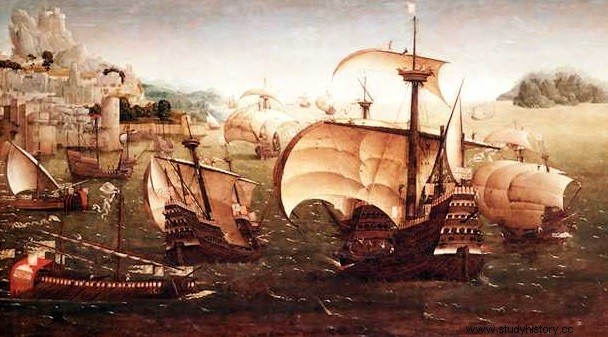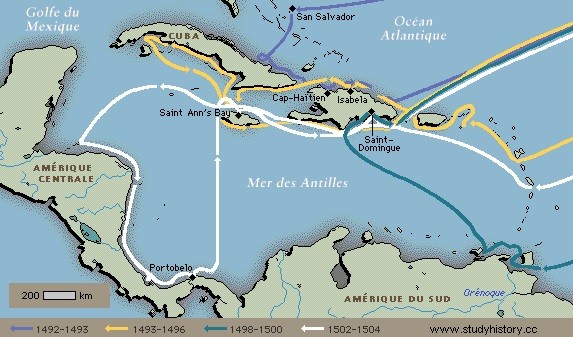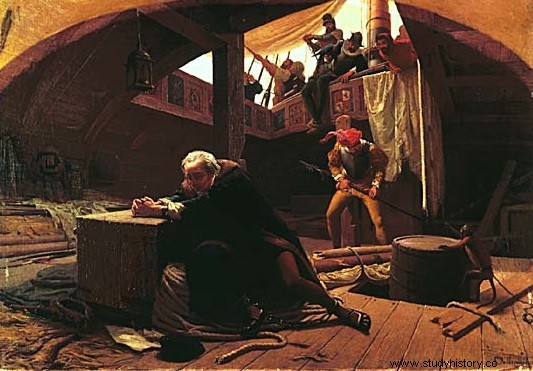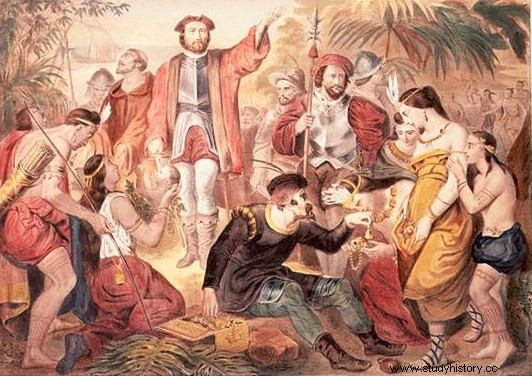 Christopher Columbus , Spanish navigator of Genoese origin, became famous for having discovered the future American continent in 1492 . Convinced that it is possible to reach the Indies from the west and despite the many reservations of his contemporaries, he ended up obtaining the financial support of the Spanish sovereigns Ferdinand of Aragon and Isabella of Castile to mount his expedition. During four successive voyages, he will explore the Caribbean and even see the continent, but will remain convinced until the end of his life of having reached Asia. He will fail to establish a permanent colonization in the discovered islands, because of the hostility of the natives, the exactions of the Spaniards and his poor qualities as an administrator. Forced to return to Spain, he fell into disgrace there, sinking for a time into oblivion.
Christopher Columbus , Spanish navigator of Genoese origin, became famous for having discovered the future American continent in 1492 . Convinced that it is possible to reach the Indies from the west and despite the many reservations of his contemporaries, he ended up obtaining the financial support of the Spanish sovereigns Ferdinand of Aragon and Isabella of Castile to mount his expedition. During four successive voyages, he will explore the Caribbean and even see the continent, but will remain convinced until the end of his life of having reached Asia. He will fail to establish a permanent colonization in the discovered islands, because of the hostility of the natives, the exactions of the Spaniards and his poor qualities as an administrator. Forced to return to Spain, he fell into disgrace there, sinking for a time into oblivion.
Who is Christopher Columbus?
Officially, Cristoforo Colombo was born in Genoa in 1451. He would be the son of Domenico Colomb, a weaver, and Suzana Fontanarossa. He has two brothers, Bartolomeo and Giacomo. His origins and his youth are not well known and he is not even sure that he was Italian, having always written in Spanish, even in his personal notes. It is possible that he belonged to a Jewish family of Spanish origin exiled in Genoa. Very young, he was passionate about navigation and science.
The Book of the Wonders of the World of Jean de Mandeville would have greatly inspired in his enterprise of discovery. Intended for the Navy, he embarked in 1476, in a convoy bound for Lisbon and England. Attacked by the French, he took refuge in Laos and found his brother in Portugal. He met Filipa Perestrelo Moniz, whom he married in 1479. This marriage enabled him to obtain navigation charts from his father-in-law Bartolomeu Perestrel, a sailor who had already explored Madeira.
 Because Christopher Columbus was always silent about his origins, some historians believe it to be a concealment strategy so as not to hinder its rise. According to the work of the historian Claude Mossé, entitled "Les Impostures de l'Histoire", a chapter devoted to our character highlights several elements converging towards the thesis of a Jewish and Catalan filiation. First, the navigator would have delayed the departure of the expedition from August 2 to 3, 1492 because, according to the author, the number 2 is considered harmful by the Jews. The explorer is said to have weighed anchor the day before the expulsion by the Spanish rulers of the Jews who had not converted to Christianity.
Because Christopher Columbus was always silent about his origins, some historians believe it to be a concealment strategy so as not to hinder its rise. According to the work of the historian Claude Mossé, entitled "Les Impostures de l'Histoire", a chapter devoted to our character highlights several elements converging towards the thesis of a Jewish and Catalan filiation. First, the navigator would have delayed the departure of the expedition from August 2 to 3, 1492 because, according to the author, the number 2 is considered harmful by the Jews. The explorer is said to have weighed anchor the day before the expulsion by the Spanish rulers of the Jews who had not converted to Christianity.
His logbook, written in Catalan, evokes the Bible as well as "the destruction of the second house" which can be likened to the Second Temple in Jerusalem. Moreover, Christophe's real name tends to prove that he is a Catalan because according to Claude Mossé:"The first notes paid to the sailor by the Kings of Spain and dated 1488 were established in the name from Colom to Seville.” He adds that “Many Catalan Jewish families were called Colom.”
What was the purpose of Christopher Columbus' voyage?
Columbus thinks that the earth is smaller than we think and that the earth is round:his goal is therefore to find a new route from India to reach Asia crossing the Atlantic Ocean. After having suffered a refusal from King John II of Portugal, it was Ferdinand of Aragon and Isabella of Castile who decided to finance his expedition. He obtained the title of admiral of the ocean sea and the viceroyalty of the territories he would discover. Martín Alonso Pinzón, a shipowner from Palos, is chosen to charter the small squadron that will venture into the Atlantic.
 Four trips will be made in this way. For the first, Columbus left on August 3, 1492 from the Canary Islands with three caravels:the Santa María, the Pinta and the Niña. On October 12, 1492, the navigator reached the island of Guanani in the Bahamas, which he named San Salvador. On October 28, the expedition reached Cuba and it was on the island of Hispaniola, the future Haiti, that he discovered gold and built a small fort there, where he left 39 men.
Four trips will be made in this way. For the first, Columbus left on August 3, 1492 from the Canary Islands with three caravels:the Santa María, the Pinta and the Niña. On October 12, 1492, the navigator reached the island of Guanani in the Bahamas, which he named San Salvador. On October 28, the expedition reached Cuba and it was on the island of Hispaniola, the future Haiti, that he discovered gold and built a small fort there, where he left 39 men.
Following the success of the first voyage, he returned to the Americas with more sailors and ships, 17 ships and 1,500 sailors. He discovered the population of the Lesser Antilles and Jamaica and founded the first European colony, that of Isabela, in what is now the Dominican Republic. During his third and fourth voyage, he continued his exploration by sailing near the island of Trinidad and the Isthmus of Panama. He thus got to know the natives and allowed Europeans to learn about other cultures, but at what cost?
The other side of Columbus's voyages
What we remember most of Columbus is the famous discovery of the Americas, yet horrors hide behind his travels. For three years, the explorer organized the looting and the submission to the tribute of the natives. Using the pretext of the cannibalism of the populations, he enslaves the inhabitants of the Caribbean, especially in the sugar cane plantations.
It creates the "repartimiento" in order to distribute the natives between the Spaniards and the colonies and which later turned into the "encomienda". This is a system, first practiced in Santo Domingo, by which a conqueror can use an Indian to make him work in exchange for evangelization. This practice will be strongly denounced by Bartolomé de Las Casas, the first ordained priest in the New World, who will come out in favor of the abolition of slavery.
 This system and methods have resulted in many outbreaks and high mortality. Queen Isabella got wind of Columbus' behavior and his slave trade. She sent Francisco de Bobadilla, a future colonial administrator, to Hispaniola to arrest Columbus for "mismanagement" and unproductiveness. He thus lost his title of Viceroy of India, and Bodadilla sent him back to Spain in 1500, in irons. The Spanish monarchs will eventually grant their pardon to the navigator, but both refuse to restore him to his post.
This system and methods have resulted in many outbreaks and high mortality. Queen Isabella got wind of Columbus' behavior and his slave trade. She sent Francisco de Bobadilla, a future colonial administrator, to Hispaniola to arrest Columbus for "mismanagement" and unproductiveness. He thus lost his title of Viceroy of India, and Bodadilla sent him back to Spain in 1500, in irons. The Spanish monarchs will eventually grant their pardon to the navigator, but both refuse to restore him to his post.
Christopher Columbus the discoverer of the Americas?
The term "discovery" is representative of the European view of the world at that time. We can also say that it was the inhabitants who discovered Spanish culture on their side, but above all, the continent before the Spaniards! Peoples already existed. Life did not suddenly appear. It is important to note that these American Indians, originally from Asia, crossed the Behring Strait on foot. during the Würm glaciation around 25,000 BC, well before Columbus. In addition, it would even appear that Africans were present 3,000 years before the Europeans. Granite colossi representing black Africans have been found within the Olmec civilization.
Among browsers, Christopher Columbus was not the first to notice this continent. Other explorers before him traveled near the Americas. This is Erik the Red , Norwegian explorer who sailed west around 980 and his son Leif Eriksson who landed in Newfoundland, Canada.
In addition, the original purpose of the expedition was to find a route to India . It is therefore by chance that he lands in the Americas. Until his death he is convinced of having found the Indies and therefore the Indians and not of having discovered a new continent. He died in complete ignorance. For him it is sure, he did not discover the Americas. Ironically, it was another Italian navigator, Amerigo Vespucci, who would give his name to the new continent.
 Christopher Columbus returns from his travels exhausted, sick with gout. He tries to have his rights and privileges recognized on the discovered lands, in vain. The Catholic kings did not want to restore his titles to him. Stripped of his privileges, the navigator died in Valladolid May 20, 1506. He was the first navigator to introduce Europeans to indigenous cultures through colonization and his stories. It paved the way for the discovery of different customs of tribes such as the Arawacks, Chibchas and Caribs.
Christopher Columbus returns from his travels exhausted, sick with gout. He tries to have his rights and privileges recognized on the discovered lands, in vain. The Catholic kings did not want to restore his titles to him. Stripped of his privileges, the navigator died in Valladolid May 20, 1506. He was the first navigator to introduce Europeans to indigenous cultures through colonization and his stories. It paved the way for the discovery of different customs of tribes such as the Arawacks, Chibchas and Caribs.
However, given the history of this continent, which does not really begin in 1492, we can say that he was not the first man to discover the America. This discovery is very controversial because some researchers see him as a faithless antihero and an impostor, cf “Christopher Colomb, the impossible hero » by Daniel Fabré. It is true that this image of a great explorer should be put into perspective because of the establishment of slavery and the massacres, resulting from the greed of the Spaniards.
Bibliography
- Denis Crouzet:Christopher Columbus:Herald of the Apocalypse. Editions Payot, 2006.
- By Jules Verne, Christopher Columbus, 1450-1506, Biography. Librio, 2003.
- The discovery of America, accounts of the voyages of Christopher Columbus. Discovery, 2015.
